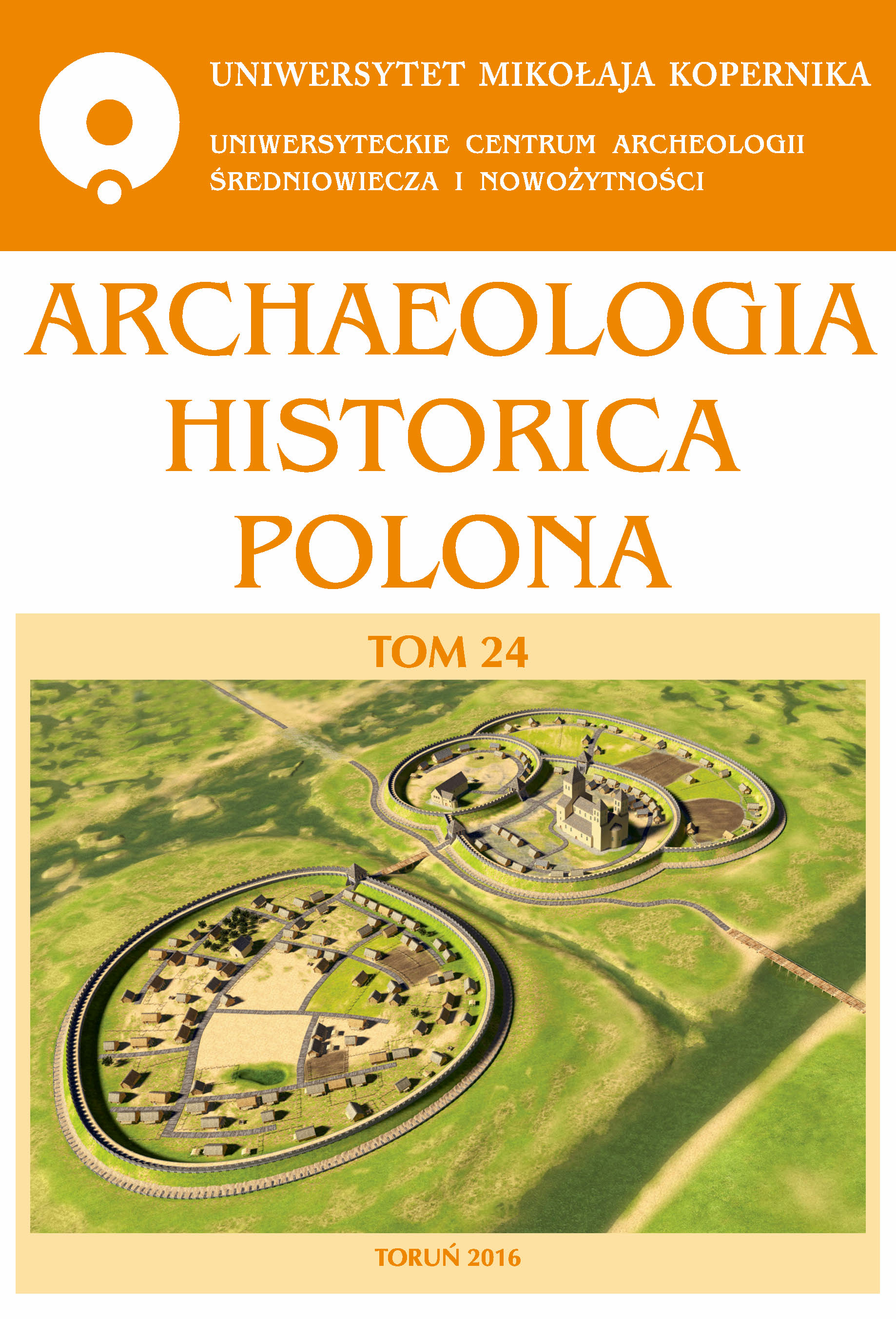Od grodu książęcego do rezydencji prepozyta kapituły. Lubin w XI–XVI wieku
DOI:
https://doi.org/10.12775/AHP.2016.004Słowa kluczowe
średniowiecze, archeologia, wyspa WolinAbstrakt
Wyniki badań wykopaliskowych przeprowadzonych w Lubinie w latach 2008–2011 oraz źródła pisane dały podstawę do rekonstrukcji osadniczej przeszłości wzgórza grodowego w średniowieczu i wczesnej nowożytności, zmieniających się w tym czasie jego funkcji oraz uwarunkowań tych przekształceń. Najstarsze ślady średniowiecznego osadnictwa należy datować na koniec IX wieku lub 1. połowę następnego stulecia. Sam gród został jednak wedle wszelkiego prawdopodobieństwa wzniesiony dopiero w 2. połowie XI wieku. W 1124 roku biskup Otton z Bambergu zbudował w nim jedną z najstarszych świątyń chrześcijańskich Pomorza. Kres znaczenia grodu nastąpił po jego zdobyciu i zniszczeniu w 8. dekadzie XII wieku przez Duńczyków. W 1186 lub 1187 roku został on przekazany kapitule kamieńskiej. W XIII wieku w miejscu dawnej osady obronnej dalej funkcjonował kościół, pełniący funkcje parafii oraz cmentarz. W następnym stuleciu doszło do całkowitej zmiany w zagospodarowaniu przestrzennym wzniesienia: kościół przeniesiono na sąsiednie wzgórze, dawne umocnienia zniwelowano, a wkrótce potem zbudowano wieżę mieszkalną, która stała się siedzibą prepozyta kapituły katedralnej z Kamienia. Obiekt został rozebrany dopiero w końcu XVI wieku, po powrocie dóbr lubińskich w ręce książąt szczecińskich.
Bibliografia
CDP – Codex Pomeraniae diplomaticus, t. 1, wyd. K. F. W. Hasselbach, J. G. L. Kosegarten, Greifswald 1862.
Herbord – Herbordi Dialogus de Vita S. Ottonis episcopi Bebenbergensis, MPH, series nova, t. VII, fasc. 3, wyd. J. Wikarjak, K. Liman, Warszawa 1974.
PUB – Pommersches Urkundenbuch, t. 1 (wyd. 2 2. Aufl.), wyd. K. Conrad, Köln–Wien 1970; t. 2, wyd. R. Prümers, Stettin 1881; t. 6, wyd. O. Heinemann, Stettin 1906–1907.
Saxo Grammaticus – Saxonis Gesta Danorum, wyd. J. Olrik, H. Raeder, Hauniae 1931.
VP – S. Ottonis episcopi Babenbergensis Vita Prieflingensis, Monumenta Poloniae Historica, series nova, t. 7, fasc. 1, wyd. J. Wikarjak, K. Liman, Warszawa 1966.
BS NF – Baltische Studien, Neue Folge, Stettin
Behla R., 1888 Die vorgeschichtliche Rundwälle im östlichen Deutschland, Berlin.
Berghaus H., 1865 Landbuch des Herzogthums Stettin, von Kammin nach Hinterpommern, II Theil, Erster Band, Berlin.
Dworaczyk M., Durdyń G., w druku Slavonic pottery, [w:] Lubin. High medieval stronghold at the mouth of the Oder, red. M. Rębkowski, H. J. Eggers.
Eggers H. J., 1960 Die wendischen Burgwälle in Mittelpommern, BS NF, t. 47, s. 13–46.
Eggers H. J., 1978 Funde der wendisch-wikingischen Zeit in Pommern, Kiel.
Eggert O., 1927 Die Wendenzüge Waldemars I. und Knuts VI. von Dänemark nach Pommern und Mecklenburg, BS NF, t. 29, s. 1–149.
Eggert O., 1928 Dänish-wendische Kämpfe in Pommern und Mecklenburg (1157–1200), BS NF, t. 30, z. 2 (Halbband), s. 1–76.
Filipowiak W., 1959 Badania archeologiczno-konserwatorskie w Lubinie, pow. Wolin, Materiały Zachodniopomorskie, t. 5, s. 311–330.
Filipowiak W., 1962 Wolinianie. Studium osadnicze, cz. 1: Materiały, Szczecin.
Gaziński R., 2006 Świna jako droga wodna w średniowieczu, Przegląd Zachodniopomorski, t. 21/4, s. 139–146.
Guzikowski K., 2016 Najazdy zbrojne na Szczecin w XII wieku. Przyczyny–przebieg–skutki, [w:] Wojna – Wojsko – Bezpieczeństwo poprzez stulecia i epoki. Studia i materiały, red. A. Aksamitowski i in., Szczecin, s. 91–100.
Hofmeister A., 1924 Zur Chronologie und Topographie der 1. Pommernfahrt des Bischofs Otto von Bamberg, Pommersche Jahrbücher, t. 22, s. 3–25.
Kiersnowscy T. i R., 1959 Wczesnośredniowieczne skarby srebrne z Pomorza. Materiały, Warszawa–Wrocław.
Kiersnowski R., 1951 Kamień i Wolin, Przegląd Zachodni, R. 7, nr 9–10, s. 178–225.
Kondracki J., 1998 Geografia regionalna Polski, Warszawa.
Kowalenko W., 1954 Piana, Świna i Dziwna jako szlaki osadniczo-komunikacyjne Słowiańszczyzny bałtyckiej VIII–XIII w., Przegląd Zachodni, 1954/1–2, s. 1–90.
Kunkel O., 1937 Burgwallforschung in Pommern, Pommersche Heimatpflege, t. 3, s. 81–92.
Küster A., 1891 Eine Sage von der Insel Wollin, Monatsblätter der Gesellschaft für pommersche Geschichte und Altertumskunde, 1891/1, s. 1–8.
Leciejewicz L., 1983 O rozwoju miast w księstwie zachodniopomorskim na przełomie XII/XIII
wieku, [w:] Studia z dziejów i kultury zachodniej Słowiańszczyzny, red. J Żak, J. Ostoja-Zagórski, Poznań, s. 121–153.
Leciejewicz L., 1993 Ośrodki władzy państwowej w księstwie zachodniopomorskim w XII w., [w:] Lokalne ośrodki władzy państwowej w XI–XII wieku w Europie Środkowo-Wschodniej, red. S. Moździoch, Wrocław, s. 63–76.
Lemcke H., 1900 Die Bau- und Kunstdenkmäler des Regierungsbezirks Stettin. Heft IV: Der Kreis Usedom-Wollin, Stettin.
Łęga W., 1930 Kultura Pomorza we wczesnem średniowieczu na podstawie wykopalisk, Toruń.
Łosiński W., 1982 Osadnictwo plemienne Pomorza (VI–X wiek), Wrocław.
Piskorski J. M., 1990 Kolonizacja wiejska Pomorza Zachodniego w XIII i w początkach XIV wieku na tle procesów osadniczych w średniowiecznej Europie, Poznań.
Raumer von G. W., 1851 Die Insel Wollin und das Seebad Misdroy. Historische Skizze, Berlin.
Rębkowski M., 2007 Chrystianizacja Pomorza Zachodniego. Studium archeologiczne, Szczecin.
Rębkowski M., 2016 Ecclesia sancti Nicolai w Lubinie. Kościół grodowy z doby pomorskich misji Ottona z Bambergu, [w:] Kościoły w dobie chrystianizacji, Wolińskie Spotkania Mediewistyczne, t. 3, red. M. Rębkowski, Szczecin, s. 225–238.
Rębkowski M., Romanowicz P., 2015 Siedziba prepozyta kapituły kamieńskiej w Lubinie na wyspie Wolin, Kwartalnik Historii Kultury Materialnej, R. 63, nr 3, s. 391–410.
Rosik S., 2010 Conversio gentis Pomeranorum. Studium świadectwa o wydarzeniu (XII wiek), Wrocław.
Rzetelska-Feleszko E., Duma J., 1991 Dawne słowiańskie nazwy miejscowe Pomorza Szczecińskiego, Warszawa.
Spors J., 1988 Studia nad wczesnośredniowiecznymi dziejami Pomorza Zachodniego XII–
pierwsza połowa XIII w., Słupsk.
Spors J., 1991 Organizacja kasztelańska na Pomorzu Zachodnim w XII–XIII w., Słupsk.
Stubenrauch A., 1898 Untersuchungen auf den Insel Usedom und Wollin, BS NF, t. 2, s. 65–133.
Ślaski K., 1960 Podziały terytorialne Pomorza w XII–XIII wieku, Poznań.
Virchow R., 1872 Ausgrabungen auf der Insel Wollin, Zeitschrift für Ethnologie, t. 4, s. 58–67.
Zöllner J. F., 1797 Reise durch Pommern nach Insel Rügen, Berlin.
Pobrania
Opublikowane
Jak cytować
Numer
Dział
Statystyki
Liczba wyświetleń i pobrań: 894
Liczba cytowań: 0



